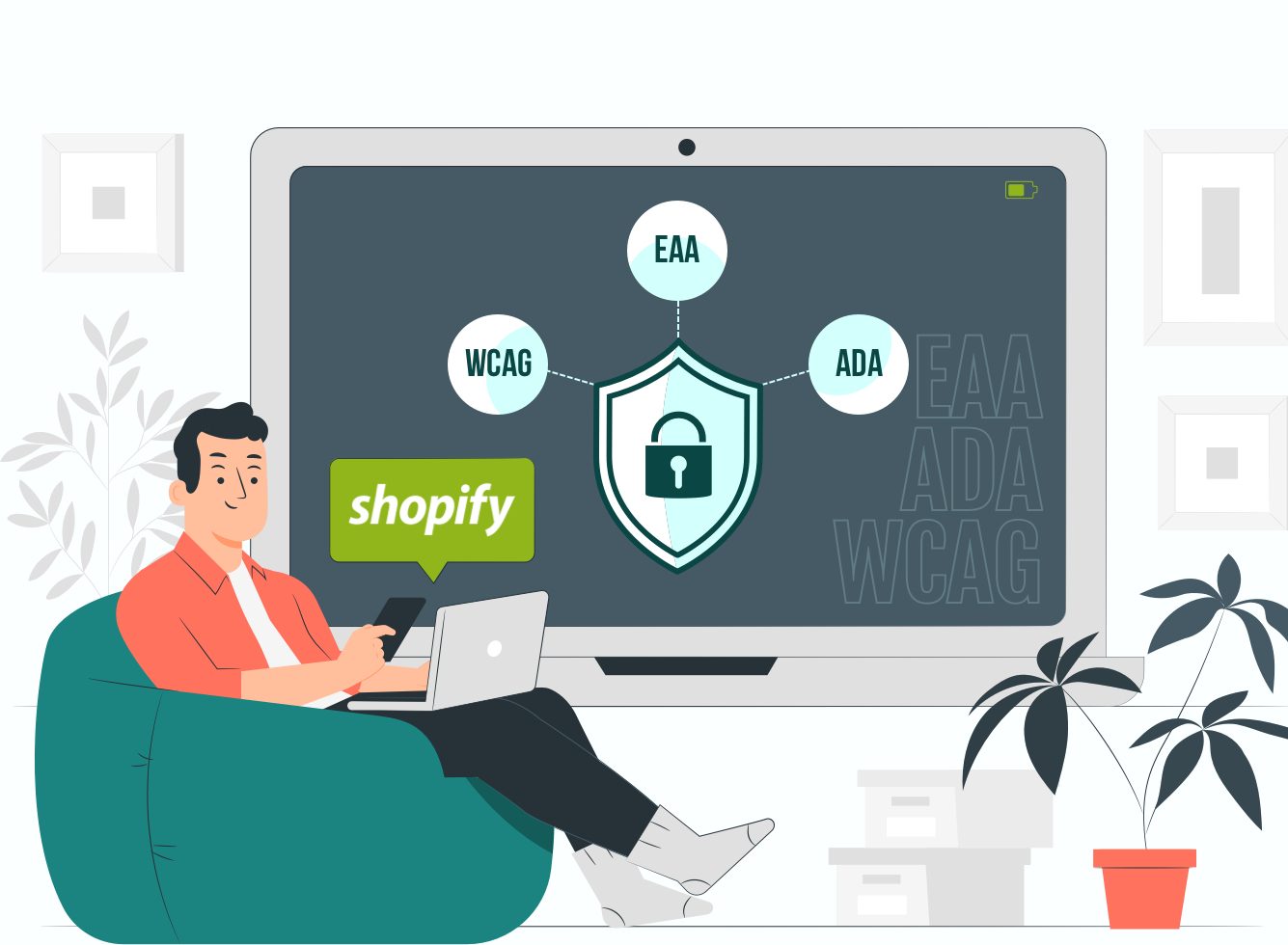An Informative Guide to Shopify Accessibility Compliance

What is Accessibility?
Many brick-and-mortar stores take steps to ensure that their premises are accessible to people with disabilities, such as providing wheelchair ramps and accessible toilets. Accessibility in the online world is about making sure that websites and digital content can be accessed and used by everyone, regardless of any disabilities they may have. Usually, it’s necessary to make some adjustments to your website in order to make it more accessible. But with the right tools and technology, you’re better positioned to ensure everyone can use and enjoy your website.
There are many reasons why Shopify website accessibility is important. Firstly, it’s a legal requirement in many countries and regions. But even when it’s not legally required, it’s still important to make sure your website is accessible to everyone. By making your website accessible, you can reach a wider audience and boost your visitors. With a higher volume of traffic, you’ll be in line to generate leads and convert them into sales.
What are the Different Accessibility Acts & Regulations?
As awareness of the importance of website accessibility has grown, more and more countries and regions have implemented laws and regulations. There are now several different accessibility laws and regulations worldwide that set out the minimum standards that websites and digital content must meet to be considered accessible. This includes the following standards below.
The Americans with Disabilities Act (ADA)
ADA is a US federal law that was enacted in 1990. It prohibits discrimination against people with disabilities in all areas of public life. ADA does not specifically mention website accessibility, but the Department of Justice has interpreted Title III (businesses that are open to the public) to include websites. This means that if your website is only accessible to people without disabilities, then you may be in violation of ADA. To comply with ADA, your website must be WCAG 2.0 Level AA compliant. For more information about ADA, you can read our previous blog post here.
Web Content Accessibility Guidelines (WCAG)
WCAG is a set of international guidelines that define how to make websites and digital content accessible. There are three levels of compliance — A, AA and AAA. Level A is the lowest level and Level AAA is the highest.
To meet the requirements of level AAA, your website must meet all the criteria outlined in the two previous levels. This is considered the gold standard for website accessibility, but it is not achievable for all forms of digital content. The WCAG guidelines are divided into four principles:
- Perceivable – Information and user interface components must be presentable to users in ways they can perceive.
- Operable – User interface components and navigation must be operable.
- Understandable – Information and the operation of user interface components must be understandable.
- Robust – Content must be robust enough that it can be interpreted by a wide range of user agents, including assistive technologies.
To comply with WCAG 2.0, your website must meet all the success criteria at Level AA. In 2018, WCAG 2.1 was released, which adds additional guidelines to Levels A and AA.
The European Accessibility Act (EAA)
The EAA is an EU directive that was enacted in 2019. It sets out minimum accessibility requirements for products and services that are used by people with disabilities. Websites are specifically mentioned in the EAA, which means that all websites that are accessible to people with disabilities must meet the guidelines set out in the directive. The EAA uses the WCAG 2.0 guidelines as a minimum standard for businesses that have websites which sell products or services in any EU member state. Many merchants hire development experts who have experience with website accessibility to guarantee Shopify EAA compliance.
The Importance of Accessibility for Your Shopify Storefront
The Internet forms an important part of daily life for people all over the world. In fact, according to a report by Statista, as of April 2022, there are over 5 billion internet users worldwide. This makes up 63% of the global population. In 2016, the UN General Assembly passed a non-binding resolution that declared Internet access as a basic human right. Since COVID-19, it’s become even more important for people to be able to access the Internet, as it’s now being used even more extensively for work, education, shopping, and socialising.
This is why it’s so important for businesses to make sure their websites are accessible to everyone, regardless of ability. Here are some more considerations to take into account.
Accessibility grants disabled people their dignity and independence – 15% of the world population is currently experiencing some form of disability, which means if your website is not accessible, you’re excluding a large portion of the population from using your site. By making some small adjustments to your website, you can make a huge difference to the lives of disabled people.
It’s good for your brand reputation – In today’s competitive climate, it’s more important than ever for businesses to have a strong and positive brand reputation. By making your website accessible, you’re showing your customers and potential customers that you’re an inclusive and forward-thinking company. This can elevate your brand reputation.
Accessibility improves website performance – Websites that are accessible to people with disabilities tend to have better website performance overall. This is because well-designed websites are usually easier to use and navigate, meaning users are less likely to get frustrated and leave the site.
Your business can avoid accessibility-based lawsuits – In recent years, there has been an increase in the number of lawsuits being filed against businesses with inaccessible websites. By making your website compliant with WCAG 2.0, you can avoid being sued for discrimination.
Visitors will have a better user experience – When you maintain Shopify website accessibility, you’re enhancing the user experience for all your website visitors. Inclusive design benefits everyone and results in a better user experience for all.
Your brand will reach a wider audience – If your website is accessible to people with disabilities, you’re opening your brand to a whole new market. A 2016 survey in the UK revealed that there are 6.1 million disabled Internet users with access needs and 71% of them will simply click away from a website if they encounter any accessibility problems. This “click-away” figure accounted for £11.75 billion of lost revenue that year.
It’s your social responsibility – Making your website accessible is not just a smart business move, it’s also your social and moral responsibility. By ensuring that your website is accessible to all, you’re making a positive contribution to society.
How to Ensure Your Shopify Storefront Complies with Accessibility Standards
Although Shopify does provide merchants with many tools and features to help them create an accessible storefront, your website will not automatically be compliant with ADA, EAA, or WCAG. This means, it’s ultimately your responsibility as the store owner to ensure that your Shopify store is compliant with all the accessibility standards. Here are some steps you can take to ensure that your Shopify accessibility is up to par.
Arrange a website audit service – One of the best ways to ensure that your website is accessible is to arrange for a website audit service. This involves having an expert review your website and provide you with a report of any accessibility issues that need to be fixed by your Shopify website developers. To follow best practices, it’s recommended that you carry out a 3-factor accessibility audit, which will use a combination of automated testing, manual testing, and assistive technology testing to give you a comprehensive overview of your website’s accessibility.
Manually remediate any accessibility issues – After you’ve received your audit report, it’s time to start manually remedying any accessibility issues that have been identified. This can be a time-consuming process, but it’s important to ensure that all accessibility issues are fixed as soon as possible. If you’re not comfortable performing the remediation yourself, you can always hire an accessibility specialist to do it for you. They will segment any issues into three categories – design issues, content issues and development issues. Once all the issues have been addressed, your website will be one step closer to Shopify EAA compliance.
Take advantage of Shopify web plug-ins – While there are many accessibility features built into Shopify, there are also a number of web plugins that can further enhance the accessibility of your storefront. These plugins can help with everything from adding alt text to images to ensuring that your website is navigable using only a keyboard. You can view and download a Shopify ADA compliance app from the Shopify app store.
Additional Measures to Ensure Shopify Accessibility
In addition to the above measures, there are several other things you can do to make your Shopify storefront more accessible. For example, you can:
- Include an accessibility statement on your website – This is a good way to let visitors know you’re committed to website accessibility and that you are taking measures to ensure your website is compliant with all the relevant accessibility standards.
- Contact disability support organisations – There are many disability support organisations (DSOs) that can provide you with advice and guidance on making your website more accessible.
- Appoint an accessibility coordinator – This is someone within your development team who will act as your Shopify accessibility expert and ensure that your website remains accessible and compliant with all the relevant accessibility standards.
- Include subtitles and transcripts for video and audio content – This will ensure that your video and audio content is accessible to everyone, including those with hearing impairments.
- Embed alternative text tags – Those with visual impairments will be able to understand what is on your website if you embed appropriate alternative text tags within images, text boxes and checkboxes.
Make Shopify Accessibility A Priority
Making your Shopify storefront accessible is not only the right thing to do, but it’s also good for business. By ensuring that your website is compliant with all the relevant accessibility standards, you will be able to tap into a whole new customer base and potentially boost your sales. If you need help with ensuring your website is compliant with accessibility regulations, you may want to hire a Shopify accessibility expert.
It’s also important to bear in mind that if your website is found to be in breach of some accessibility regulations, you could face heavy fines or litigation procedures. In the US, you could be fined up to $75,000 by the Department of Justice for breaching the Americans with Disabilities Act. So, if you’re not already doing so, make accessibility a priority for your business and take the necessary steps to ensure that your website is compliant.






